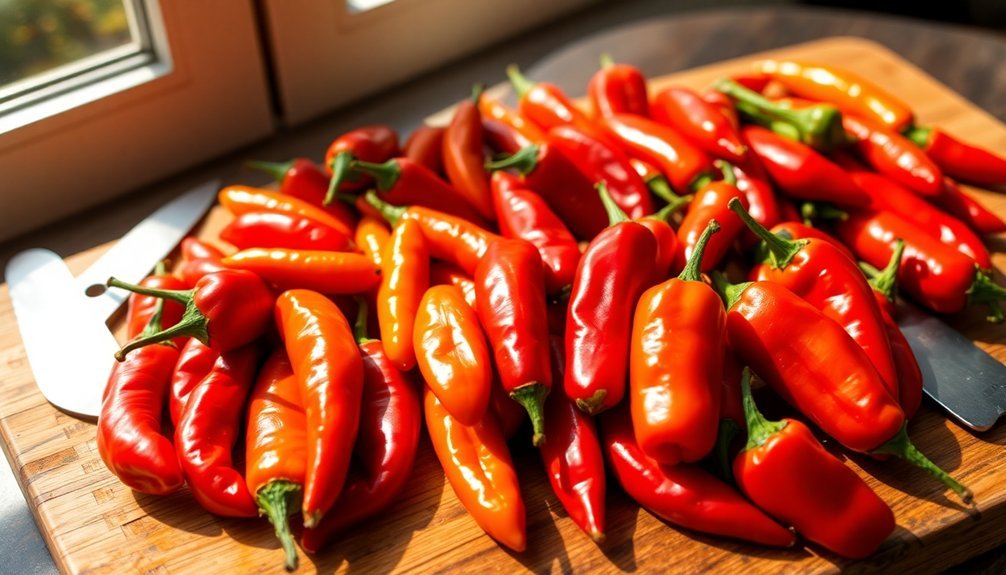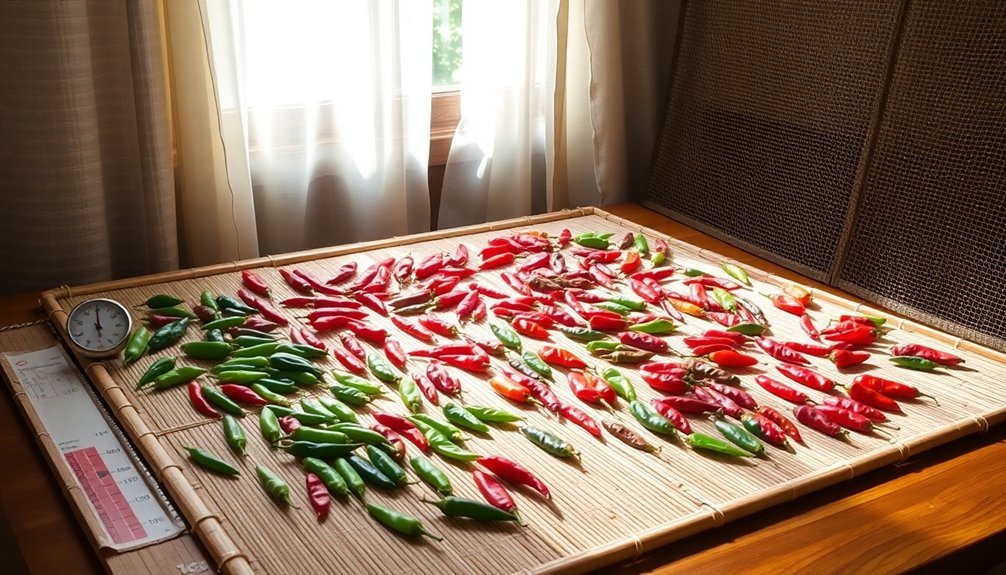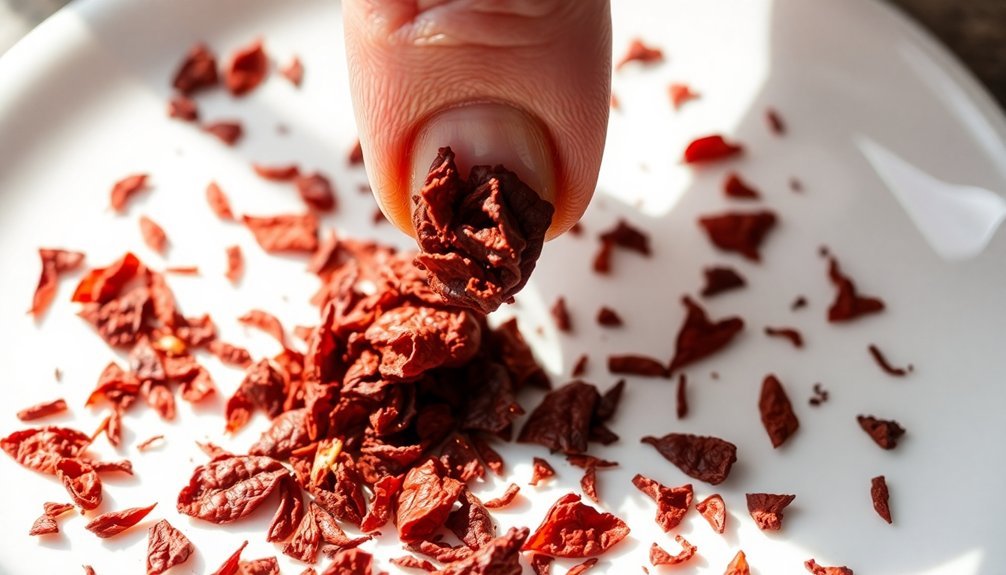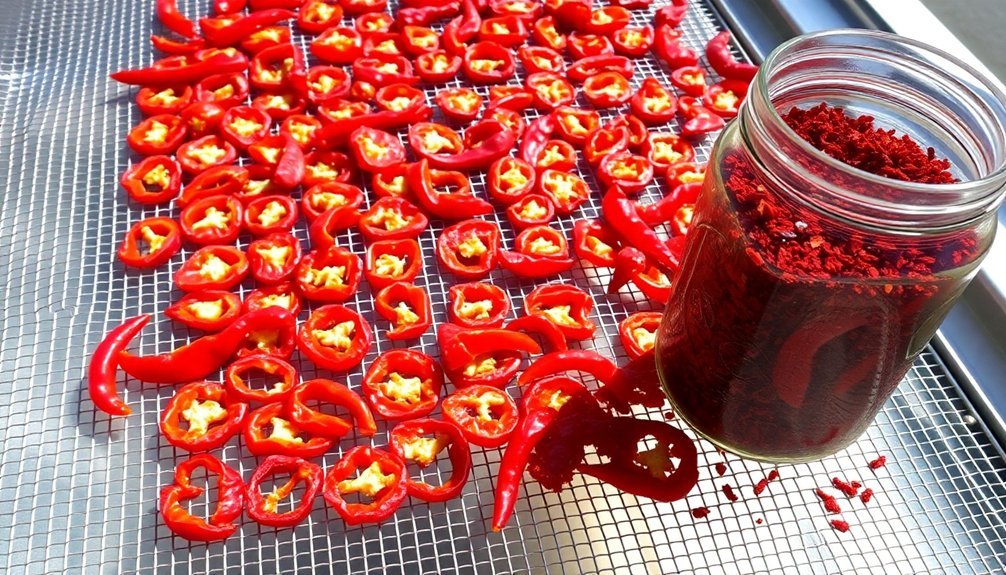Making sun-dried pepper flakes starts with selecting fresh hot peppers like serranos, cayenne, or bird peppers – avoiding bell peppers due to their mild flavor. You'll need to clean your peppers thoroughly, remove stems if desired, and slice larger ones in half. Next, hang them in an area with good airflow and indirect sunlight, using butcher's twine or fishing line. Monitor daily for 1-2 weeks until they're brittle and snap cleanly. Once fully dried, crush them using a spice grinder or mortar and pestle, then store in airtight containers. Proper technique and timing will guarantee your homemade pepper flakes pack the perfect punch.
Select Your Fresh Peppers

The selection of fresh peppers is essential for creating flavorful dried pepper flakes. You'll find that serranos, poblanos, and small hot peppers are ideal choices for your drying project.
If you're looking for more heat, consider habaneros or Trinidad Scorpion Butch peppers, which pack intense flavor and high capsaicin content.
While you can use any pepper variety, including bell peppers, they're not the best option due to their mild nature and lack of heat.
For optimal results, choose cayenne, bird peppers, or wiri-wiri, which you can dry whole.
Remember that the drying process intensifies both heat and flavor, so consider this when selecting your peppers.
You can also create unique flavor profiles by combining different pepper varieties in your batch.
Checking peppers for freshness and quality before drying will ensure the best possible outcome for your dried pepper flakes.
Clean and Cut Peppers
Now that you've chosen your peppers, proper cleaning and preparation will guarantee the best results for your dried pepper flakes.
First, inspect each pepper carefully for soft spots, mold, or unusual odors, and discard any that show signs of spoilage. Wash your peppers thoroughly under clean water to remove dirt and contaminants, then pat them dry.
You'll need to decide whether to remove the stems and seeds. While most methods leave the seeds intact, you can cut larger peppers in half and remove the inner membranes if you prefer smoother flakes. Always remember to wear protective gloves when handling hot peppers to prevent skin irritation.
For smaller varieties like cayenne or bird peppers, you can leave them whole. If you're planning to sun-dry your peppers, consider applying a very light coating of high-heat oil like coconut oil to prevent bacteria growth.
Set Up Drying Area

Selecting an ideal drying location marks an essential step in creating sun-dried pepper flakes. You'll want to choose a spot with good airflow and indirect sunlight, such as your kitchen, greenhouse, or near a window. A curtain rod above a window can serve as an excellent hanging spot.
Set up your drying area in a well-ventilated space with moderate sun exposure, but avoid areas with high humidity or excessive moisture. This traditional process of drying peppers has been a time-tested preservation method used across cultures for centuries.
When hanging your peppers, use butcher's twine or heavy-duty fishing line to string them. Thread through the pepper stems or tie loops around them, ensuring you leave enough space between each pepper for proper air circulation.
Don't forget to secure the string with sturdy hooks or rods, and check the knots periodically to prevent any peppers from falling.
Monitor The Drying Process
You'll need to check your drying peppers daily for proper brittleness, ensuring they're pliable but not moist.
Keep your peppers protected from rain and morning dew by covering them or bringing them indoors during adverse weather conditions.
Rotate your drying trays regularly throughout the day to promote even drying and prevent any sections from receiving too much or too little sun exposure.
Traditional sun drying methods can take one to two weeks until completion, so patience is essential.
Check Daily For Brittleness
Regular monitoring of your drying peppers is essential to achieve the perfect texture and prevent over-drying.
You'll need to check your peppers twice daily, ideally in the morning and afternoon, to track their progress toward brittleness.
To test for dryness, gently touch the peppers and try to bend them. When they're properly dried, they'll break easily rather than flex, and you'll hear seeds rattling inside.
The peppers should be crunchy with a wrinkled skin and deeper color. Don't rush the process – sun-drying can take several days to a week, depending on your climate and the thickness of your peppers.
Remember to rotate your peppers periodically to guarantee even drying.
This low and slow approach will help you achieve the ideal brittle texture needed for making pepper flakes.
Protect From Weather Elements
While monitoring your peppers for brittleness, protecting them from harsh weather elements is equally important. You'll need to shield your peppers from direct sunlight, wind, and moisture to guarantee ideal drying conditions. Cover them with cheesecloth or thin mesh to protect against birds, insects, and dust while maintaining proper air circulation.
| Weather Element | Protection Method | Why It's Important |
|---|---|---|
| Sunlight | Thin mesh/towel cover | Prevents excessive heat |
| Wind | Sheltered location | Maintains even drying |
| Humidity | Well-ventilated area | Prevents spoilage |
| Dust/Debris | Cheesecloth cover | Keeps peppers clean |
| Birds/Insects | Fine netting | Prevents damage |
Keep the humidity level below 60% and guarantee the drying area maintains temperatures above 90°F. Choose a protected space like a covered porch or greenhouse where you can control these conditions effectively.
Rotate Drying Trays Regularly
Proper rotation of drying trays stands as an essential step in creating high-quality pepper flakes. You'll need to rotate your trays every 2-3 hours to guarantee even drying and prevent hot spots from affecting your peppers.
Keep a close eye on different-sized peppers, as smaller ones will dry faster than larger ones. Monitor moisture levels carefully while maintaining a temperature between 130-170°F. You'll know your peppers are ready when they're crunchy and brittle.
Don't forget to remove any peppers that have already dried to prevent over-processing. Keep your trays clean and avoid overcrowding them, as this can lead to steaming instead of drying.
For best results, use separate trays for different pepper varieties to maintain distinct flavors and guarantee proper air circulation throughout the drying process.
Test For Complete Dryness

You'll know your peppers are completely dry when they snap cleanly in half rather than bend.
Listen for a distinct crumbling sound when you break the peppers, as this indicates they've reached the proper level of dryness.
If the peppers don't break easily or make a crunching noise, they need more drying time.
Break Test Method
Determining whether sun-dried peppers are completely dry requires a simple yet effective break test.
You'll know your peppers are ready for processing when they exhibit a brittle, crunchy texture that breaks cleanly when bent. There shouldn't be any flexibility or moisture present.
- Peppers must snap cleanly with a crisp sound when bent
- No signs of dampness, stickiness, or leathery texture
- Color should be uniform and vibrant, with no mold
- Surface should feel completely dry to the touch
- Pepper should shatter rather than bend when pressure is applied
Once your peppers pass this break test, they're ready for grinding into flakes.
If they don't break cleanly or show any flexibility, return them to continue drying.
You'll want to store properly dried peppers in airtight containers in a cool, dry place.
Crumbling Sound Check
A reliable sound check provides one of the best indicators of properly dried peppers. When you bend a fully dried pepper, it should make a distinct cracking or snapping sound. If you hear this crisp sound, you'll know the peppers are ready for crushing into flakes.
Listen carefully as you test each pepper – they shouldn't be flexible or bend without breaking. The sound will be sharp and clean when the moisture content is zero. You'll want to check multiple peppers from different areas of your dehydrator to verify even drying throughout your batch.
Once you've confirmed the proper crumbling sound, you can safely transfer your peppers to an airtight container for storage.
Remember to process them in a way that protects your hands from irritation, either using gloves or a food processor.
Crush Into Flakes
Transforming sun-dried peppers into flakes requires careful attention to both safety and technique.
You'll find several effective methods to achieve the perfect consistency, each offering unique benefits for your desired outcome.
Choose your preferred crushing method based on your batch size and texture preference:
- Place dried peppers in a plastic bag and crush by hand or with a rolling pin for coarse flakes
- Use a spice grinder or food processor for quick, efficient processing of larger batches
- Opt for a mortar and pestle when you want precise control over the texture
- Wear protective gear like masks and gloves to avoid irritation from spicy fumes
- Sift the crushed peppers through a fine mesh strainer to guarantee uniform flakes and separate any powder
Remember to process only completely dried, brittle peppers for the best results.
Store For Long Term

Proper storage techniques will greatly extend the shelf life of your sun-dried pepper flakes while preserving their vibrant color and spicy kick.
Keep them in airtight glass jars or mason jars with tight-fitting lids, and store them in a cool, dark pantry away from heat sources and direct sunlight.
For ideal freshness, maintain storage temperatures between 60-72°F and keep humidity levels low.
You'll want to transfer your flakes from their original packaging into your chosen containers right away.
For long-term preservation, consider vacuum-sealing portions or freezing them in airtight bags.
If you're in a humid climate, add silica gel packets to your storage containers or opt for refrigeration.
Before each use, check your flakes for any signs of mold, brittleness, or off-putting odors to verify they're still fresh.
Frequently Asked Questions
Can Pepper Flakes Be Mixed With Other Spices During the Drying Process?
You shouldn't mix pepper flakes with other spices during drying, as it can cause uneven moisture levels and unwanted flavor transfers. It's best to dry peppers separately and blend them afterward for better results.
How Do You Adjust Heat Levels When Mixing Different Pepper Varieties?
You can control heat levels by adjusting the ratio of mild to hot peppers. Use more mild peppers for less heat, or increase spicier varieties for more intensity. Always test as you mix them.
Will Pepper Flakes Maintain Their Color After Long-Term Storage?
Your pepper flakes will maintain color longer if you store them properly. Keep them in opaque, airtight containers away from light and moisture, and maintain consistent cool temperatures between 60-70°F for best results.
Can You Rehydrate Pepper Flakes for Use in Sauces?
Yes, you can rehydrate pepper flakes for sauces, but you'll get better results using whole dried peppers. If you try with flakes, soak them in hot water for 15-20 minutes before blending.
Are There Special Considerations When Drying Peppers in Humid Climates?
In humid climates, you'll need extra precautions. Use a dehydrator or fan for consistent airflow, cut peppers uniformly, and bring them inside at night. Monitor closely for mold and guarantee proper ventilation throughout drying.
In Summary
Now you're ready to enjoy your homemade sun-dried pepper flakes. You'll taste the difference between these fresh-made seasonings and store-bought varieties. If you've followed these steps carefully, your flakes will stay fresh for up to six months when stored properly. Don't forget to label your containers with the date and pepper variety. You'll never want to buy pre-made pepper flakes again.





Leave a Reply